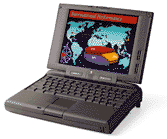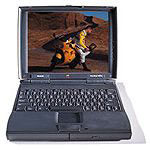Sometimes it's nice to have a backup PowerBook. In this article,
I will outline the PowerBook 5300
series and 1400 series, and
explain why you might consider one of them as a second machine.
The PowerBook 5300 series was released in 1995, and after a
number of recalls and REA's, it became a  stable machine. Since it was the first
PowerBook to use a PowerPC processor, it sold well. All 5300s use
PCMCIA slots for a modem or ethernet card, all have trackpads, and
all feature removable floppy drives.
stable machine. Since it was the first
PowerBook to use a PowerPC processor, it sold well. All 5300s use
PCMCIA slots for a modem or ethernet card, all have trackpads, and
all feature removable floppy drives.
The 5300 came in four versions. The first version, the plain
5300, had a grayscale screen. It featured 8 MB of RAM, a 500
MB hard disk, a 9.5" grayscale screen, and a 100 MHz PowerPC 603e
processor.
The second version, the 5300cs, featured 8 or 16 MB of RAM, a
500 MB or 750 MB hard drive, a 10.4" dual scan colour screen (it
isn't bad for a Dual Scan screen), which can show 256 colours at
640*480, and a 100 MHz 603e.
The third version, the 5300c, featured 16 MB of RAM, a 750 MB or
1 GB hard drive, a 10.4" active matrix colour screen, which
supported thousands of colours, and a 100 MHz 603e.
The last version, the high-end version, was the only 5300 to use
a 117 MHz 603e processor. It was called the 5300ce and featured 16
MB of RAM, a 1 GB hard disk, and the same 10.4" active matrix
screen as the 5300c.
Despite the problems of the 5300 series, the flaming batteries
(only on some prototype units), the cracking case, and logic boards
that needed to be replaced all to often, the 5300 was a solid
machine, a decent performer, and a good value for your money once
these problems were overcome. Most that you see now have gone
through the REA program from Apple which fixes known issues with
the 5300 series PowerBooks.
In fact, the 5300 makes a wonderful second laptop. The small
size makes it ideal to slip into your bag with your current laptop,
and the PowerPC processor makes it possible for you to run Mac OS
9.1 and applications such as Microsoft Word 2001
and AppleWorks 6.
The 5300 is also capable of handling MP3 files. Set up SoundApp PPC
and copy over a few of your favourite MP3s, and you've got a nice
little jukebox.
The best things about the 5300 are the price and the size. The
5300 is a tiny laptop - add about an inch to the 10.4" screen on
the width and height, and you've got a 5300. The price is great
too. On eBay
you can often get a 5300cs for less than $200. Don't
buy one without at least 32 MB of RAM unless you can either live
with less or are willing to spend the money necessary to upgrade
the RAM to a decent amount (64 MB is the maximum).
The PowerBook 1400 is another machine. There were several
versions of this machine; all  used an
11.3" screen. Like the 5300, the 'cs' models used a dual-scan
screen (somewhat blotchy, not as sharp as active matrix, the
graphics are much slower), and the 'c' models used active matrix
screens, which were very good.
used an
11.3" screen. Like the 5300, the 'cs' models used a dual-scan
screen (somewhat blotchy, not as sharp as active matrix, the
graphics are much slower), and the 'c' models used active matrix
screens, which were very good.
First there was the PowerBook 1400cs/117 and the c/117. Forget
these unless you plan to upgrade to G3 or just use it for very
basic tasks - the 117 MHz 603e is too slow for more advanced things
that the faster 1400s are capable of, especially because it has no
L2 cache. For the price you pay for one of these you can get
yourself a 5300c/100 or 5300ce/117, which will do all the same
things as the 1400/117 series - and probably have more RAM and a
bigger hard drive too. This was also the only model not to include
the CD-ROM drive expansion module as standard. It was an optional
extra.
Then there was the PowerBook 1400cs/133 and c/133. These were
nice computers and came with 16 MB of RAM and a 750 MB or 1 GB
hard drive.
The high-end model was the 1400cs/166 and c/166. These used a
166 MHz PowerPC 603e processor and had 16 MB of RAM plus a
1 GB or 2 GB hard drive.
The nice thing about the 1400 series is that they are G3
upgradeable. Newer Technology made 216, 250, and 266 MHz upgrades.
Sonnet Technology makes a 333 MHz card. Right now I am typing this
in Microsoft Word 2001 while listening to an MP3 in the background
in iTunes, on my 1400c/166 upgraded to a 216 MHz G3 with the Newer
Tech card and running Mac OS 9.1. That gives you some idea how
useful the G3 upgrade makes a plain 1400. (Okay, a plain 1400 could
probably handle that, but barely. Playing an MP3 demands a lot of
processing power). In fact an upgraded 1400 could probably be a
decent only computer for some.
However, like the 5300, the RAM can only be upgraded to 64
MB.
The 1400 also has a few unique features worth mentioning. First
is the BookCover insert. This replaces the front of the top cover
with a clear piece of plastic, ready for you to insert one of the
provided picture/painting inserts or whatever you have at home that
fits. The 1400 was also the first PowerBook to use a CD-ROM drive,
and there were several models made for it, a 6x, 8x, and 12x (there
was no way to use an internal CD-ROM drive on a 5300). Like the
5300, there is a video out card for displaying an image on an
external monitor. The card in the 1400 supports up to a 16"
display. The 1400 was so popular that many docks and other
accessories were made, especially by Newer Technology. Major Mac
retailers, such as MacWarehouse and MacMall, are still selling
PowerBook 1400 batteries.
The 1400 is clearly superior to the 5300 series, but the price
might hold you back. A 1400c/166 typically sells on eBay
for $350-$400 with 32 or 48 MB of RAM and a 1 GB hard disk. A
cs/166 model might be able to be had for $275-$325. A c/117
typically sells for $175-$200 with 16 MB of RAM and a 750 MB hard
drive. A similar 5300c/100 can be had for under $150 with the same
amount of RAM and the same size hard drive.
So, it comes down to three factors.
- Speed. Yes the 1400 is faster, but for some things you don't
need the extra speed - especially if you just want to type.
- Size. The 5300 has a smaller screen, so the whole thing is
smaller. The 1400 has a bigger screen, but is heavier and
larger.
- Price. The 5300 is cheaper than the 1400. In my opinion, the
1400's price is too high right now; I just don't know if a 166 MHz
PowerPC 603e is worth $400 when you can get a nice 200 MHz 603e
3400c for the same if not less, and a 100 or 117 MHz 603e 5300 for
under $200 - and sometimes under $100!
Right now it looks as if the 5300 is the better value in terms
of what you get for your money, but the 1400 is the best of both
machines in speed and upgradeability, since it can be upgraded to a
G3 and the 5300 cannot. In a future article I will talk a bit about
the 3400, 3500, and G3 Series models.

 stable machine. Since it was the first
PowerBook to use a PowerPC processor, it sold well. All 5300s use
PCMCIA slots for a modem or ethernet card, all have trackpads, and
all feature removable floppy drives.
stable machine. Since it was the first
PowerBook to use a PowerPC processor, it sold well. All 5300s use
PCMCIA slots for a modem or ethernet card, all have trackpads, and
all feature removable floppy drives. used an
11.3" screen. Like the 5300, the 'cs' models used a dual-scan
screen (somewhat blotchy, not as sharp as active matrix, the
graphics are much slower), and the 'c' models used active matrix
screens, which were very good.
used an
11.3" screen. Like the 5300, the 'cs' models used a dual-scan
screen (somewhat blotchy, not as sharp as active matrix, the
graphics are much slower), and the 'c' models used active matrix
screens, which were very good.
